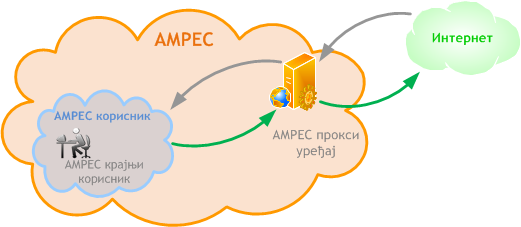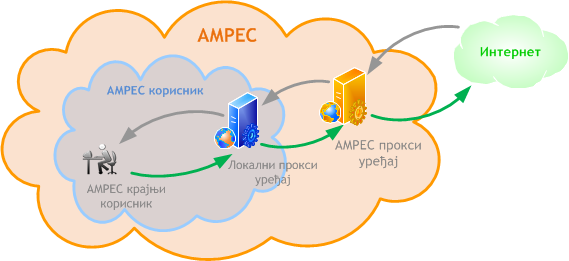Web-proxy
Web-proxy service increases security of end users’ devices in the way that it blocks access to web pages that have viruses or other malicious contents. This service is realized by proxying HTTP and HTTPS traffic of end users. Filtering of web-contents is additionally performed in order to preserve primary function of Academic Network, and it is provision of high-quality Internet access for the needs of scientific and education community in the Republic of Serbia.
Within the service of connecting to AMRES infrastructure, AMRES users are obliged to use web-proxy service when accessing the Internet. Proxying of web traffic means that users exchange HTTP/HTTPS traffic with the Internet via proxy device in the central hub of Academic Network. Additionally, AMRES users have possibility to regulate policy of acceptable contents on their own by additional filtering of categories or web-pages for their end users within web-filtering service.
In accordance with abilities of AMRES proxy device, policy of acceptable contents was created for all AMRES users. More information about policy of acceptable contents may be found in method of work of AMRES proxy device. AMRES users may select one of two ways of proxying the traffic of their end users described below.
Centralized Proxying
Centralized proxying means that AMRES end users perform their communication with the Internet via AMRES proxy devices in the central hub of Academic Network. Communication is performed in this case based on the path "end user – AMRES proxy devices – Internet" and vice versa.

If AMRES user opts for centralized proxying, it is necessary to set use of AMRES proxy server in Internet browsers of end users. The person in charge of technical contact of AMRES user is responsible for setting user computers and he/she has duty to help end users when setting Internet browser. Instructions for Setting of Proxy Device within Internet Browser (Serbian version only) can be used for this purpose or the person in charge of technical contact of AMRES user may make special instructions for his/her users.
Local Proxying
Local proxying means that AMRES user uses his own (local) proxy server. In that case, it is necessary to set local proxy device so that it forwards all traffic to the Internet via AMRES proxy device (so-called parrent method of work). Communication is performed in this case based on the path "end user – local proxy device of AMRES user – AMRES proxy devices – Internet" and vice versa.

If AMRES user opts for local proxying, it is necessary that the person in charge of technical contact provides instructions for setting of local proxy devices in Internet browsers for its end users.

